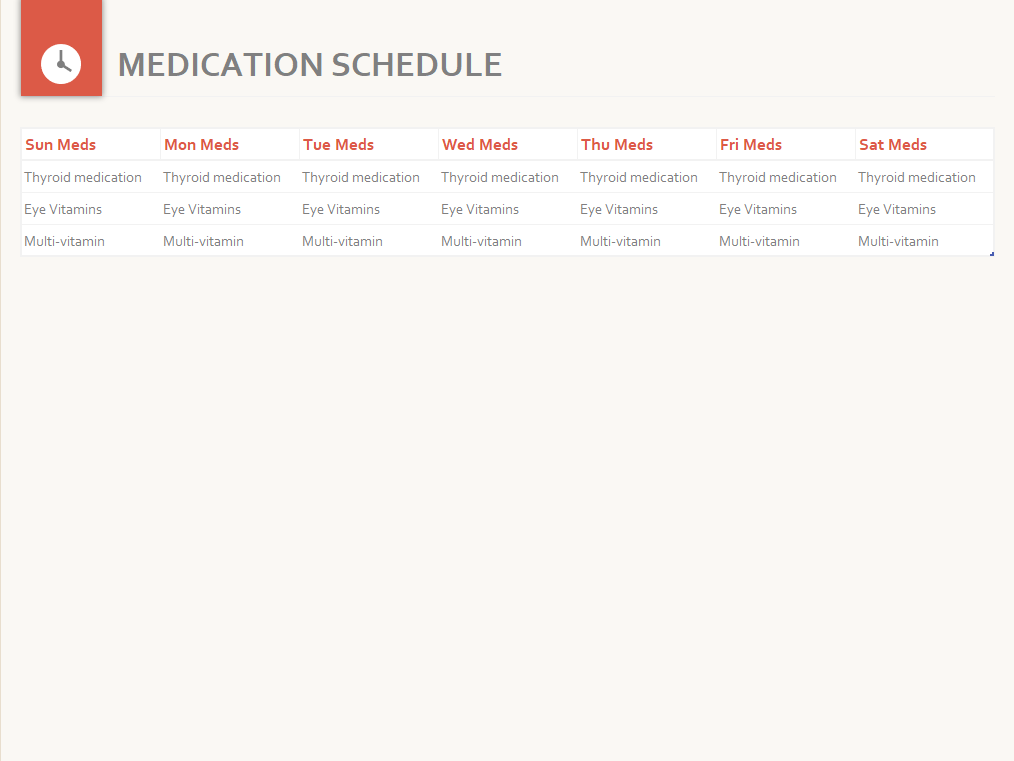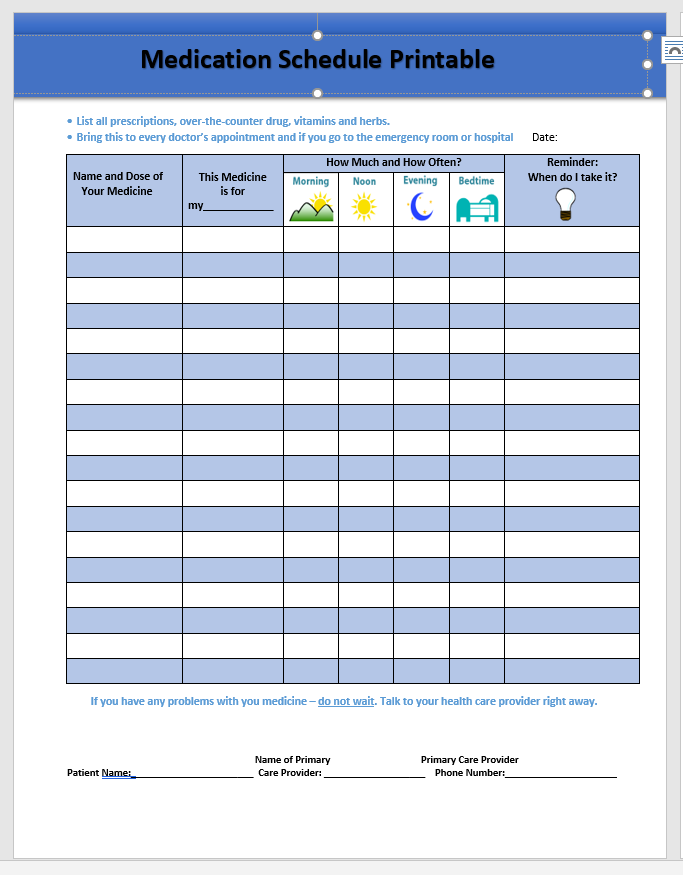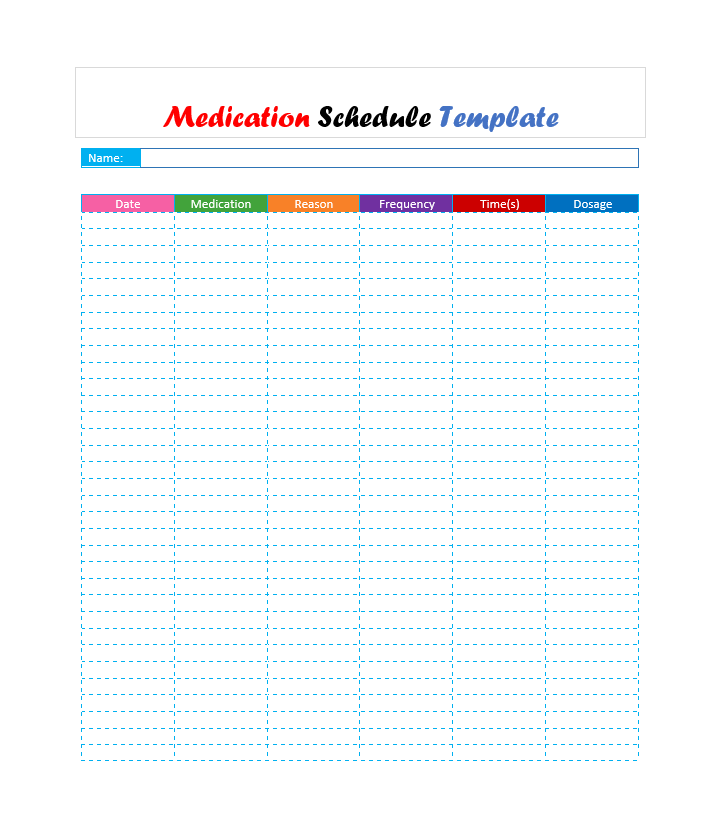The medication or medication schedule template benefits those with medical problems who regularly intake the prescribed medicines. You should know that using a medicine schedule will help you get all the important things when caring for your patients. It is a reminder about the regular intake of medicines that have been prescribed and a patient’s medical history. You can use the daily medical schedule, making anything easier in every aspect of your job. Let’s learn more about it!
Types of medical schedule templates
Here are several types of medical schedule templates that you can use
As a basic rule, each family member, from children to the older ones, should get the medical check-up regularly. To make anything easier, you can download medical schedule templates to track any medical information for all family members. You can download them or make your medical schedule based on your needs. Here, there are some types of medical templates that you can use.
Health medication schedule template
You can use this template as another easy way to help you manage your medical plans. It is very important for those who live alone and do not have anyone who takes care of them. It is also very important to note all the safety measures in medication and track your daily intake of herbs, vitamins, pills, etc.
Daily medication schedule template
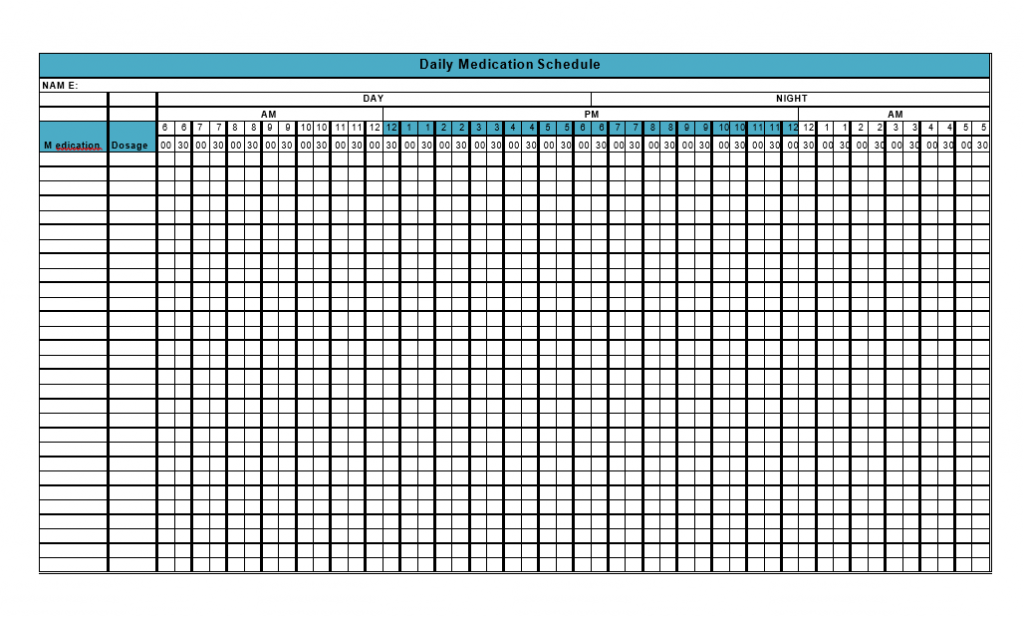
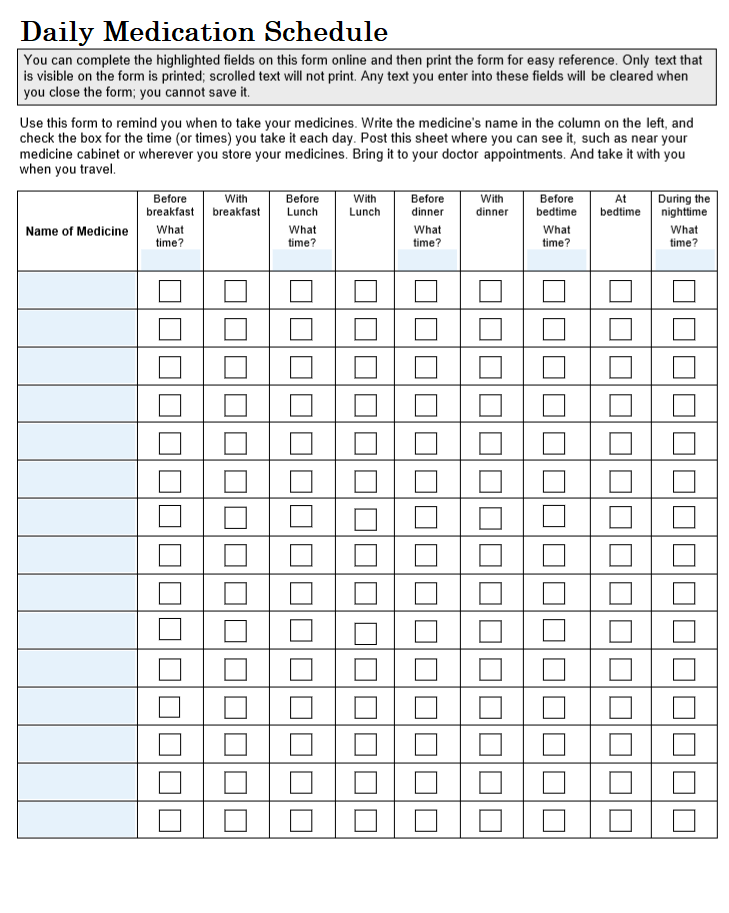
As its name implies, this schedule was specifically designed to track the daily dosage a person needs to take to fulfill their doctor’s prescribed medical routines. It is a very simple template you can use in the hospital, even at home. It still helps people who need to manage their medical schedule while doing their activities in the workspace or at home.
Medication schedule organizer
This type of template can assist patients and healthcare providers manage medications and laboratory tests. If you are good at computer work, you can adjust the template to employ reminders, track the medication routines, and help send information to healthcare providers.
There are other types of medical schedule templates that you can download or make on your own, such as weekly schedule templates, monthly schedule templates, etc. You can choose one of the best ones based on your preference.
Other types:
Hourly medication schedule template
- What is it? This schedule tells us which medicine to take every hour.
- Who is it for? People who need medicine many times in one day.
- The special thing is that it has a space to write notes for each hour.
Monthly medication schedule template
- What is it? This schedule shows our medicine for the whole month.
- Who is it for? People with long treatments or monthly check-ups.
- The special thing is that we can see our whole month’s health plan.
Weekly medication schedule template
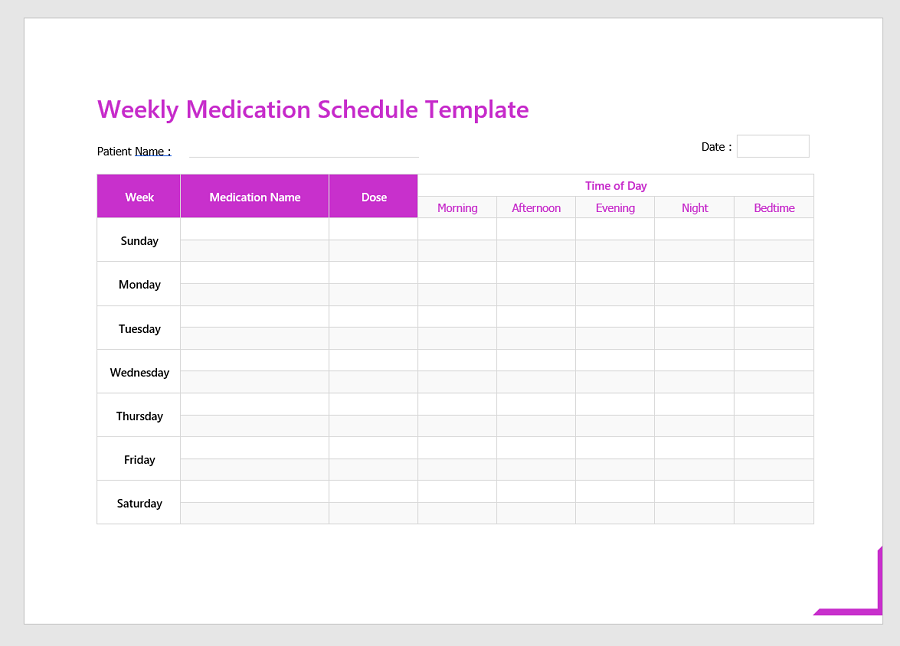
- What is it? A chart for one week of medicine.
- Who is it for? People with short treatments or weekly check-ups.
- The special thing: It helps us plan our week better.
Doctor Visit schedule
- What is it? A schedule to remember our doctor visits.
- Who is it for? People who see the doctor regularly.
- Special thing: We can write what the doctor said or what we want to ask next time.
The Importance of Using a Medication Schedule
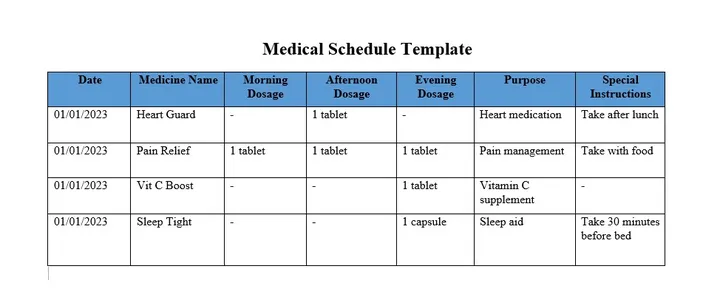
Long-term Planning:
- Always Be Ready: Medication schedules can be designed for the long run, not just for a few days or weeks. This long-term view helps in ensuring you always have essential medicines.
- Handle Surprises: Life can throw unexpected events at us. A long-term plan means we are better prepared to handle surprises without disrupting our medication routine.
Avoiding Medication Errors:
- Stay Safe: With so many things on our minds, we can forget to take a pill or take it twice. A medication schedule is a safety net, ensuring we take the right medicine at the right time.
- Peace of Mind: Knowing that there’s a system in place reduces stress.
A Tool for Healthcare Providers:
- Better Doctor Visits: When we visit the doctor, they need to know about our medicines. An updated schedule provides a clear picture, helping doctors understand our medication routine. It can make check-ups quicker and more effective.
- Easy Adjustments: If there’s a need to change a medicine or its dosage, having a schedule makes it easier. The doctor can see what we’re taking and suggest changes without guesswork.
Boosts Adherence:
- Stick to the Routine: It’s not just about avoiding mistakes. A schedule helps us stick to our medication routine. Regularly taking medicines as prescribed increases their effectiveness.
Easy Monitoring:
- Track Progress: We can see how well we stick to our medication routine over time. It’s a sign that we must make changes if we need doses.
- Share with Loved Ones: Family members or caregivers can also check our schedule. This way, they can support our health journey and step in if they notice something’s off.
Essential elements of a medication schedule template

It must have specific elements to ensure effective, clear, and easy to understand. Here are the essential elements to include:
Patient’s Name and Details:
- It helps identify whose schedule it is, especially if there are multiple patients or family members.
Medication Name:
- List each medication to avoid confusion.
Dosage:
- State how much medicine to take, like one pill or 5 ml.
Timing:
- Mention when to take the medicine. For example, 8 AM, 1 PM, 6 PM.
Frequency:
- How often should the medicine be taken? Daily, every other day, or once a week?
Purpose:
- Why is the medicine being taken? It helps in understanding its importance.
Start and End Date:
- Some medicines are only for a while. Knowing when to start and stop is crucial.
Special Instructions:
- Some medicines must be taken with food, and others must be kept in the fridge. Note down any special steps here.
Doctor’s Name and Contact:
- In case of doubts or emergencies, having the doctor’s contact handy is good.
Pharmacy Details:
- Where was the medicine bought? It helps if you need to get more or ask questions.
Notes or Reactions:
- A space to write any side effects or reactions after taking the medicine.
Color Coding:
- Colors can help quickly identify morning, afternoon, or night medicines.
Visual Aids:
- Pictures of the medicine or symbols can make the schedule more user-friendly, especially for those who can’t read well.
Emergency Contact:
- A number to call if something doesn’t feel right after taking the medicine.
These elements in your medical schedule template ensure that all medicines are taken correctly and safely. Always show your schedule to a doctor or nurse to check everything.
Why Need a medication schedule template?
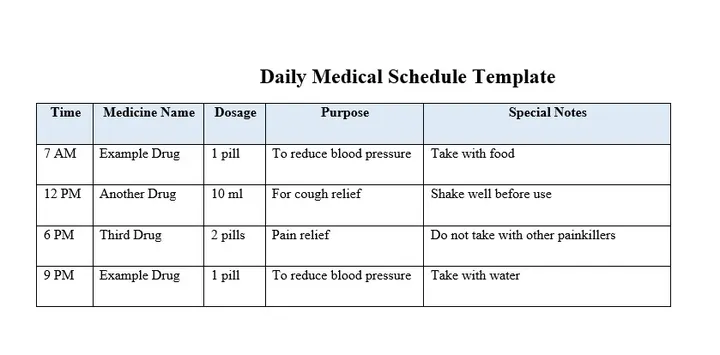
Taking care of our health is one of the most important things we can do. When our loved ones are sick or have a medical condition, we must remember medicines, doctor visits, and other health tasks. Here’s why a medical schedule template can be so helpful:
Never Miss a Medicine
Sometimes, we have to take more than one medicine. A schedule reminds us which medicine to take and when. This way, we won’t forget or mix them up.
Stay on Track
Some medicines must be taken at specific times, like before eating or bed. A template helps us stick to these times, so the medicine works best.
Doctor Visits
Doctor appointments are important. We don’t want to miss them! A medical schedule can remind us of our next visit.
Safety First
Taking too much medicine or it at the wrong time can be harmful. A template ensures we take the right amount at the right time.
Easy to Share
If we have a caregiver or family members helping us, they can also see our schedule. This way, everyone knows our medicine routine.
Remember Refills
Running out of medicine is not good. A schedule can remind us when it’s time to get a refill.
Peace of Mind
Having everything written down means we don’t have to keep trying to remember it all. We can relax, knowing our health routine is organized.
Special Notes
Sometimes, there are special instructions or things we need to remember about our health. A template has space for these notes.
Stay Healthy
Following a medical routine gives us the best chance to get better or stay well.
How to Make Your Medical Schedule
Creating a personalized medical schedule streamlines tracking and managing medication dosages, appointments, and health activities.
He is a step-by-step guide that will help you design a tailored schedule:
- Decide on the Format:
- Paper vs. Digital: Some people prefer a physical paper schedule, while others might want a digital version on their computer or phone. Decide which works best for you.
- Gather All Necessary Information:
- List of Medications: Write down every medication you take, including the dosage.
- Intake Times: Note the times you need to take each medicine. Some might be daily, while others could be weekly or even monthly.
- Choose a Template:
- Ready-made Templates: Many websites and apps offer pre-made medication schedule templates.
- DIY: Create your own using tools like Microsoft Excel, Google Sheets, or any calendar app.
- Fill in the Details:
- Medication Name: Write the name of the medication.
- Dosage: Note the amount and strength (e.g., 500mg).
- Frequency: Indicate how often you need to take it (e.g., twice a day, every Monday).
- Special Instructions: Add any specific instructions, like “take with food” or “avoid sunlight.”
- Set Reminders (for Digital Schedules):
- Alarms: If using a digital format, set up alarms or notifications to remind you to take your medication.
- Recurring Reminders: For daily medications, set the reminder to repeat at the same time every day.
- Highlight Important Information:
- Color-coding: Use different colors for morning, afternoon, and evening medications.
- Symbols: Use symbols like stars or exclamation points for crucial medicines or doses.
- Update Regularly:
- New Medications: Whenever you get a new prescription, add it to your schedule.
- Stop Taking: If you stop a medication, remove it or cross it out.
- Review with a Healthcare Professional:
- Accuracy: Next time you see your doctor or pharmacist, show them your schedule to ensure everything is correct.
- Feedback: They might have suggestions or spot something you missed.
- Keep It Accessible:
- Visible Spot: If it’s a paper schedule, pin it on your fridge or bedside.
- Digital Copies: If digital, ensure you can easily access it on your device. Consider printing a backup copy.
- Share with Caregivers or Family:
- Backup: If someone helps care for you or if there’s an emergency, they’ll know your medication routine.
- Support: They can also help remind you if you forget.
Tips for Making the Medical Schedule Template
Here are some tips for making the medical schedule template.
- Clear Names: Start by writing big, clear names like “Medicine,” “Amount,” “Time,” and “Reason.”
- Use Colors: Use different colors for morning, afternoon, and night medicines. For example, yellow for morning and blue for night. It helps you quickly know when to take them.
- Pictures Help: Put small pictures or drawings beside the medicine names. A sun for morning pills and a moon for nighttime ones.
- Specify Dosage Amounts: Write down how many pills or syrup you must take. For instance, “2 pills” or “1 teaspoon.”
- Set Alarms: If you use a computer or phone, set alarms to remind you. It’s like a friend saying, “Hey, it’s time for your medicine!”
- A Space for Notes: Leave some space to jot down extra details. You may have felt different after taking a pill or missed a day.
- When to Stop: Write when you started the medicine and when you should end. This way, you will only take it as long as needed.
- Feelings or Side Effects: Have a section to note if the medicine made you feel any different or if you had any reactions.
- Easy to Find: Place your schedule where you’ll see it often, like on your fridge or beside your bed.
- Update When Needed: If your doctor adds a new medicine or changes something, update your schedule.
- Ask for Help:Before you finalize your schedule, show it to someone older, like your doctor or a parent. They can check if it’s correct.
- Keep It Safe: If it’s digital, save a backup. If it’s on paper, make a spare copy.
- Make It Simple: Your schedule should be easy to read. Anyone in your family should be able to understand it!
Having this schedule is a great help. It reminds you about your medicine and ensures you’re on track to feeling your best!
Free Medication Schedule Template
medication log
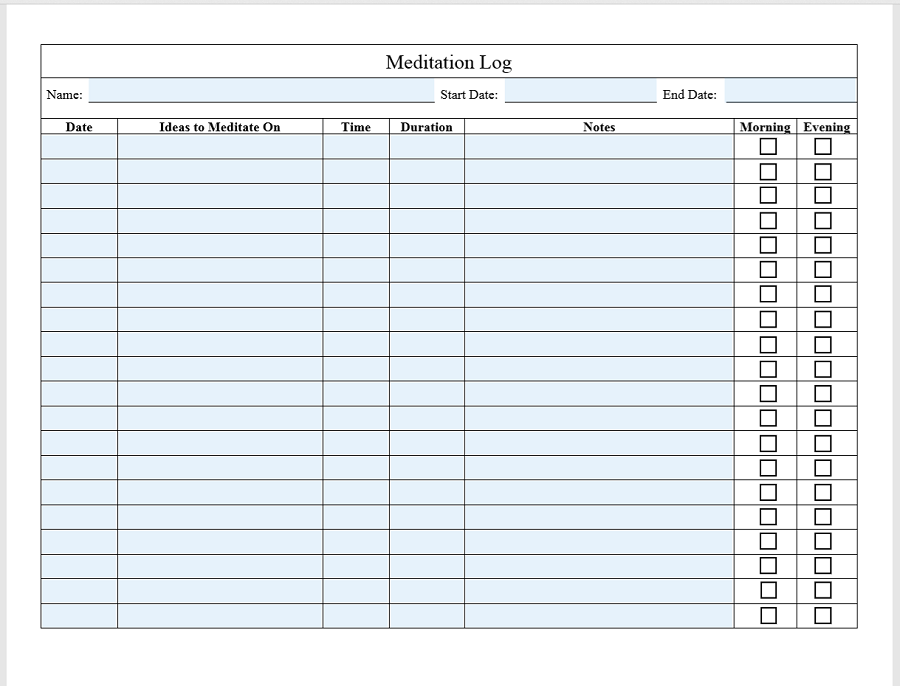
Medication Schedule Printable
personal medication list
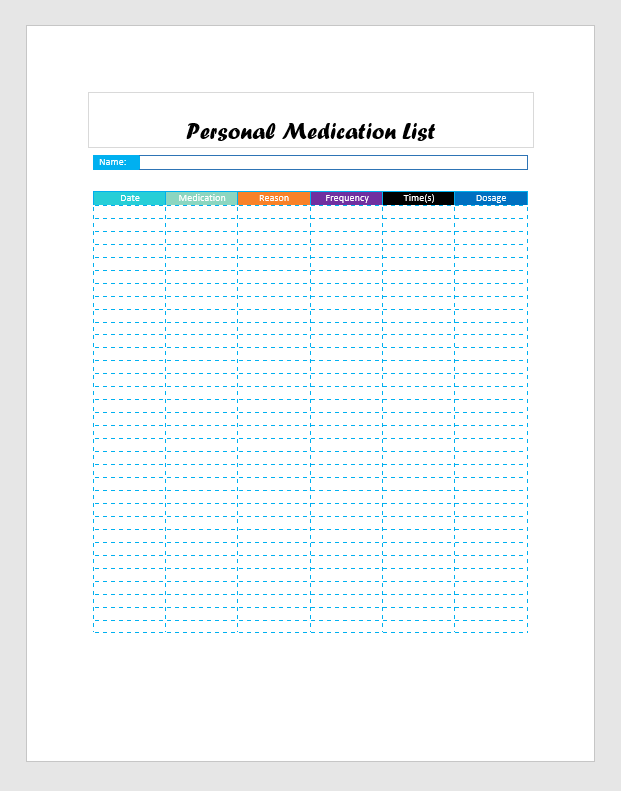
Weekly Medication Chart
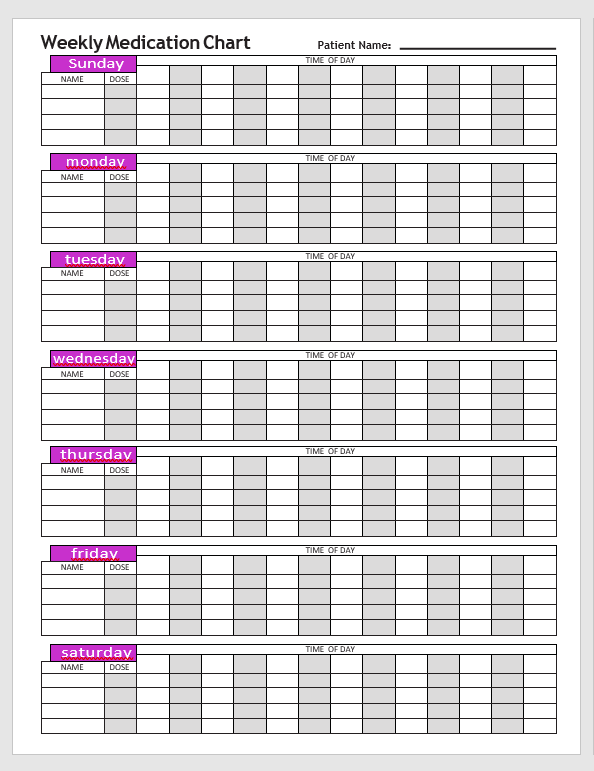
Drug Schedule Chart
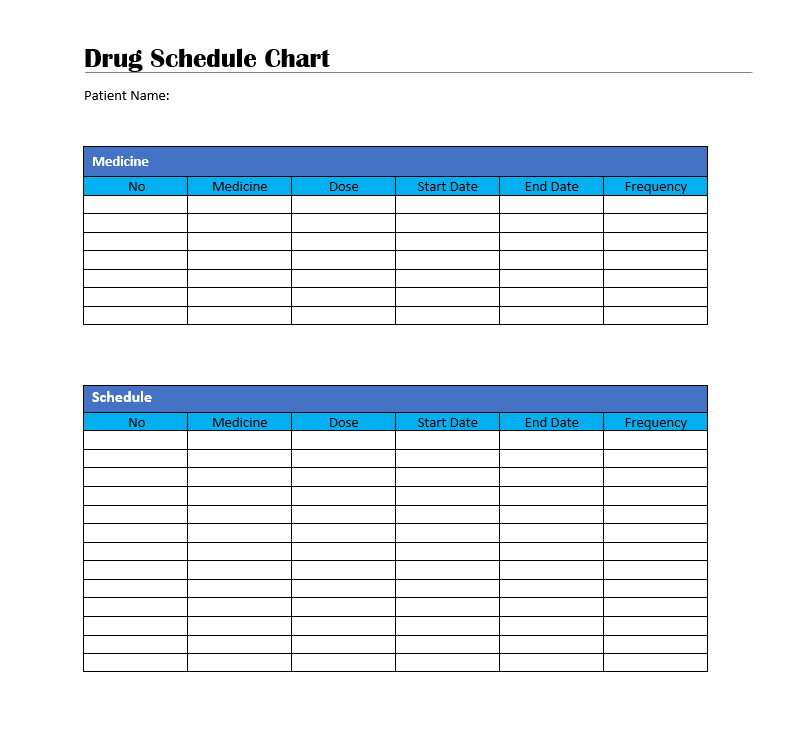
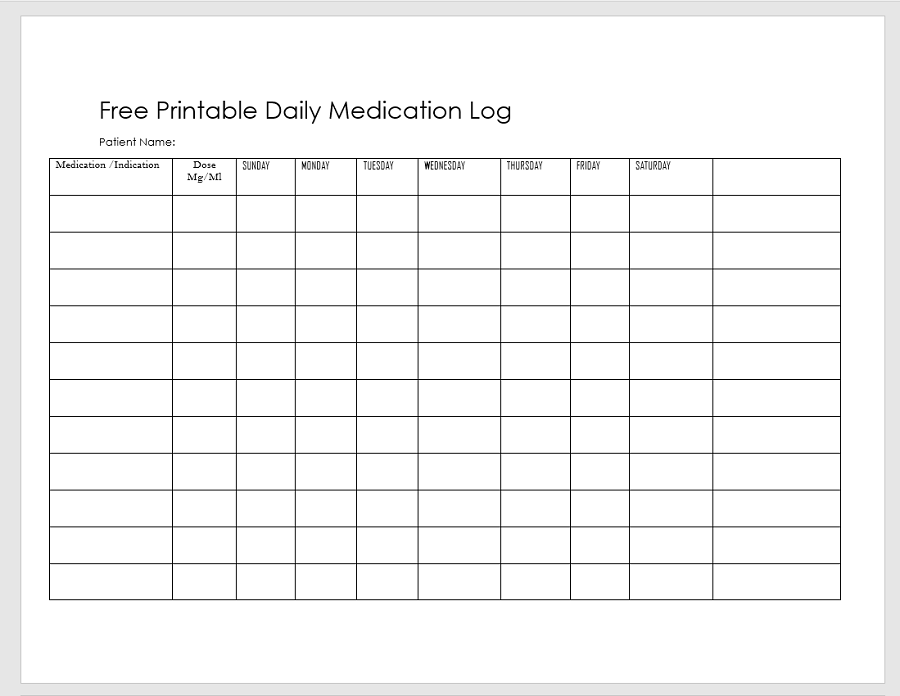
Medical Administration Record Sheet
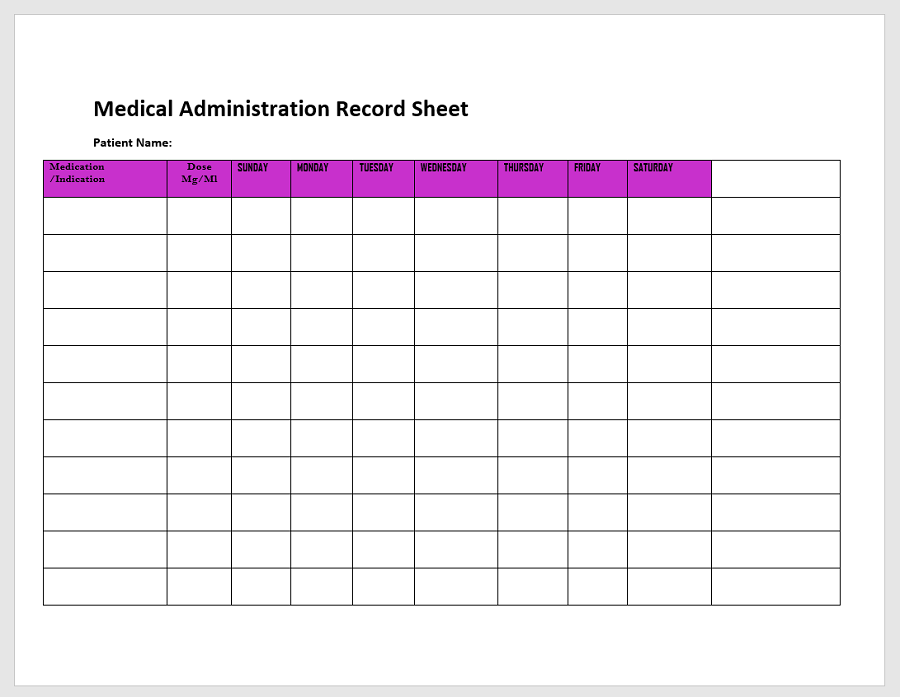
Medication Calendar
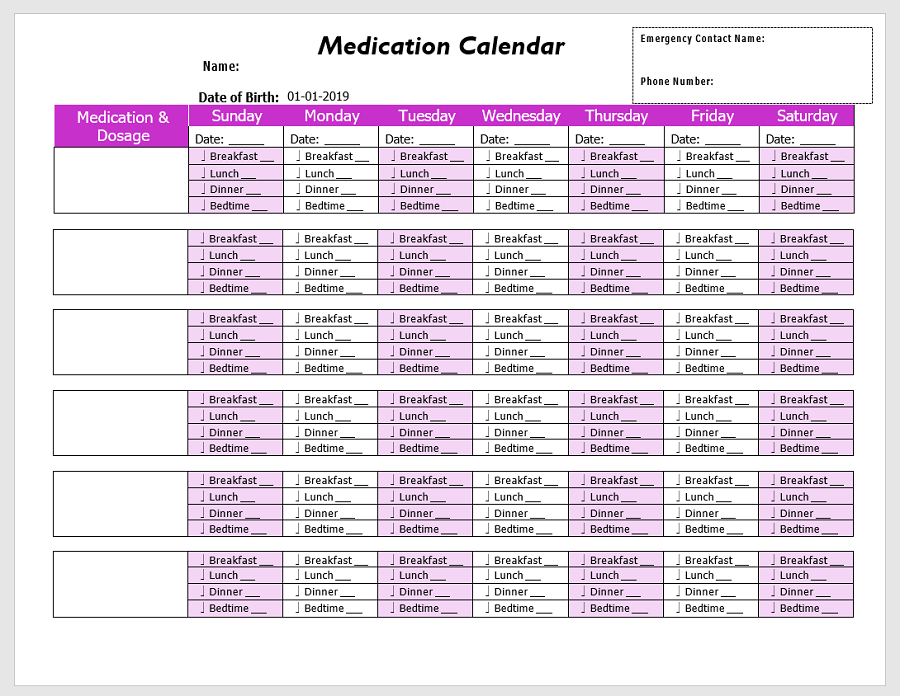
Medication Chart
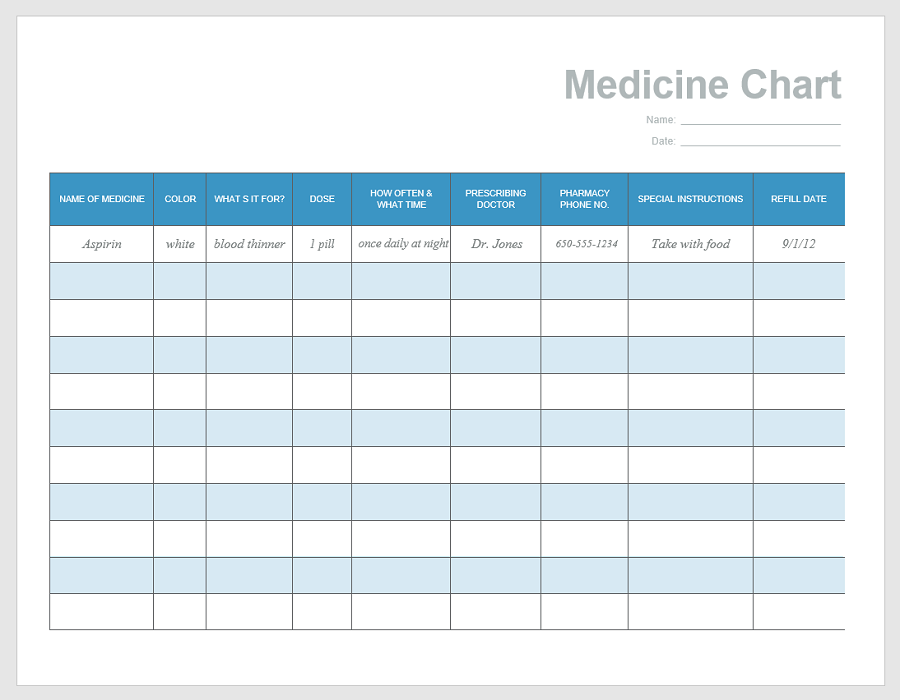
Medication Chart PDF
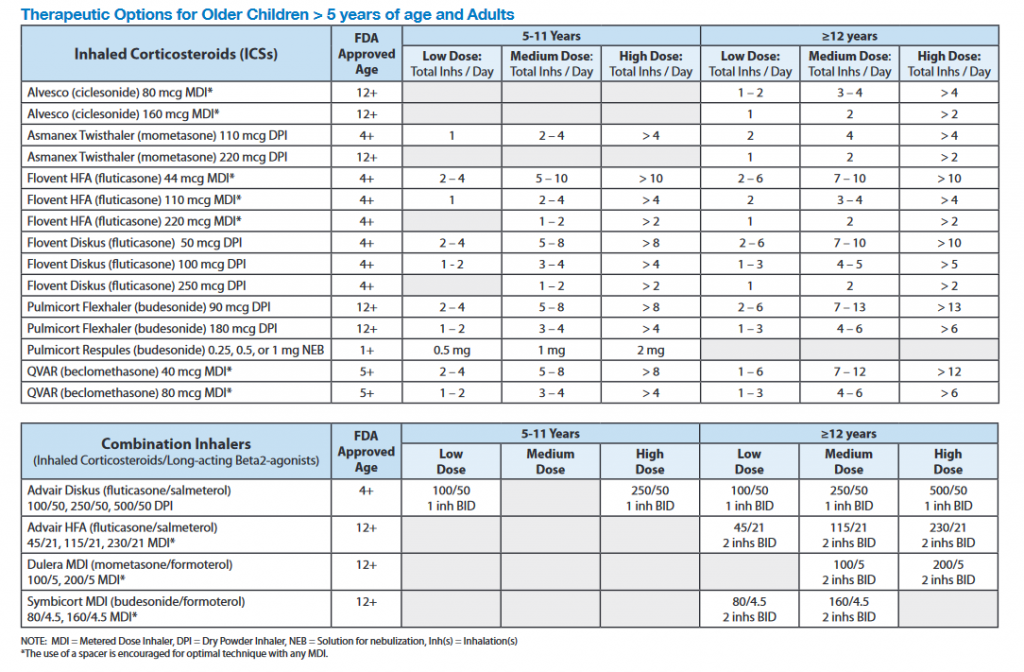
Medication dosing schedule
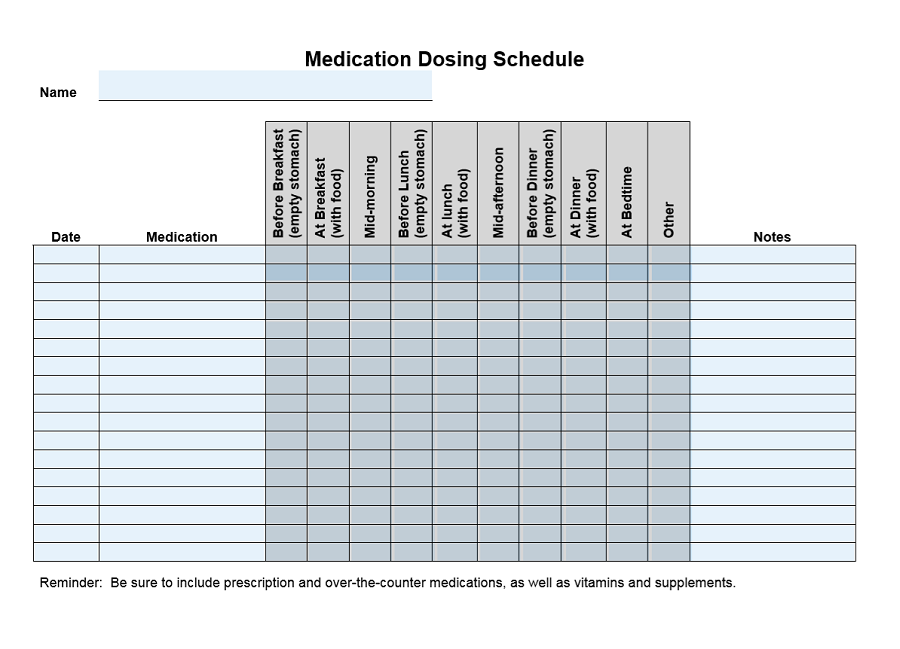
Medication list template
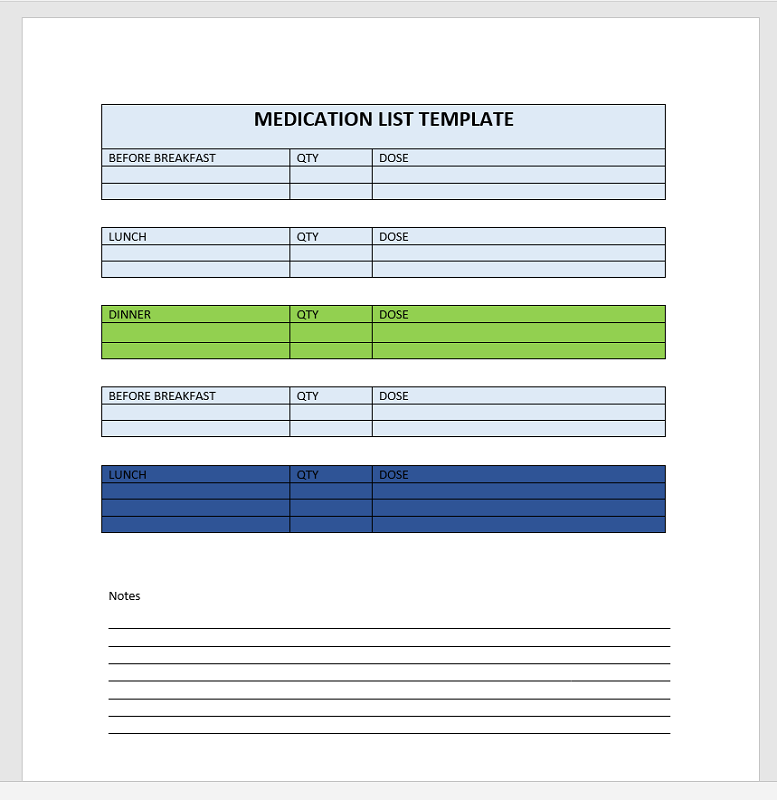
Common Mistakes
There are some common mistakes in Medication Schedule Template:
- Not Being Specific: Simply writing “morning” or “evening” can be unclear. It’s better to specify exact times, like “8 AM” or “6 PM”.
- Overloading Information: Ensure the schedule is clear. Stick to the most crucial points.
- Forgetting to Update: If your medication changes or dosage is adjusted, updating the schedule is essential to avoid mistakes.
- Ignoring Visual Aids: Symbols, colors, and images can make a schedule easier to follow. Ignoring these can lead to understanding.
- Not Having a Notes Section: A section for notes or side effects is crucial. It can lead to important observations being remembered.
- Lack of Backup: Stacking it up can be risky using a digital template. Similarly, if it’s a physical copy, not having duplicates can be problematic if the original is lost.
- Not Reviewing with Healthcare Professionals: It’s always a good idea to have a doctor or pharmacist review the schedule to ensure accuracy.
- Using Medical Jargon: The template should be easily understood by anyone, not just medical professionals. Avoid using complex medical terms.
- Missing Duration: Not mentioning how long a medicine should be taken (e.g., 10 days or 3 weeks) can lead to overuse or underusing medication.
- Lack of Flexibility: Life can be unpredictable. If a medicine is missed, there should be clear instructions or a way to make a note of it.
- Not Grouping Similar Medications: If you’re taking multiple medicines simultaneously, group them on the schedule for clarity.
- Not Including All Medications: Forgetting to list vitamins, over-the-counter medicines, or occasional medications can result in accidental overdoses or negative interactions.
- Ignoring Dosage Amounts: Simply writing the medicine’s name without its dosage can be confusing and risky.
Knowing these common mistakes, you can create a more effective and safe medical schedule template.
Conclusion
Taking care of our health is very important. Medication schedules help us remember when to take our medicine. It makes us feel better and get well faster. But always remember to ask a doctor or nurse about your medicine schedule. They can help make sure it’s perfect for you.
FAQs
What is a Medication Schedule Template?
It’s a helpful tool that reminds you when to take your medicines. It lists down names of medicines, when to take them, and more.
Can I make my own?
Yes, you can! There are also many templates online, but you can create one that fits your needs.
Is it just for pills?
No, it’s for all types of medicines. You can include creams, liquids, and even vitamins!
How often should I update it?
Whenever your doctor changes your medicine or gives you a new one, update your schedule.
Can others use my template?
Sure! If someone in your family takes medicines, they can use it too. But each person should have their schedule.
What if I miss a dose?
It’s okay. Write it down in your notes section and tell your doctor. They will tell you what to do next.
Can I use it on my phone?
Yes! There are apps for that, or you can use a digital template version.
How detailed should it be?
It should have all the important information, but it should also be easy to read and understand.
Why are there pictures and colors?
They make your schedule fun and easy to use. Pictures can quickly show you morning or nighttime medicines, and colors can help you see different times of the day.

The content creator team at calipsotree.com is dedicated to making topics accessible to everyone, with over 9 years of experience in writing and breaking down complex concepts into easy-to-understand articles that answer readers’ financial questions.






